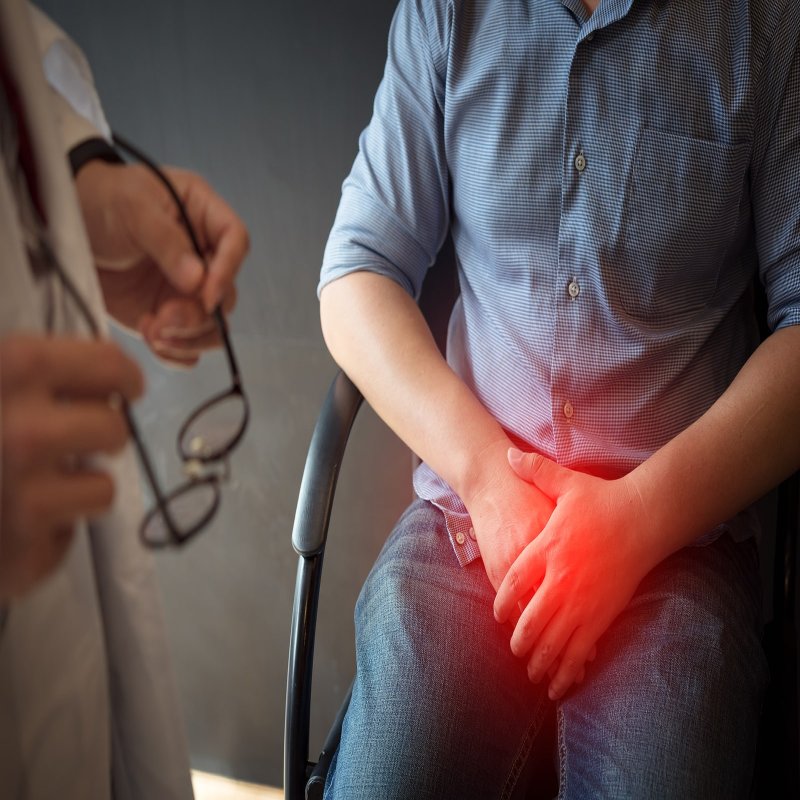
Testicular cancer is one of the rare cancers and tends to mostly affect men between 15 and 49 years of age. India has one of the lowest incidences of testicular cancer with less than 1 man in every 1,00,000 affected by this disease. The incidence might be less at a younger age, but awareness can help prevent it from developing to an advanced stage. Read on to know all about testicular cancer treatment, diagnosis, risk factors and much more.
As the name suggests, it develops in the testicles, which is a part of the male reproductive system. The functions of the testicles are to produce both sperm and androgens, primarily testosterone. It is highly treatable and curable when diagnosed early. So how can you catch testicular cancer early in its track?

Signs
Men may experience a variety of symptoms or signs. Usually, a small lump or area of hardness is the first sign of testicular cancer. The symptoms mostly appear after cancer has spread to other parts of the body.
Some prostate cancer signs and symptoms may include:
- A lump or enlargement in either testicle
- A feeling of heaviness in the scrotum
- Mild pain in the abdomen or groin
- Fluid accumulation in the scrotum
- Pain in a testicle or the scrotum
- Back pain

Cancer usually affects only one testicle. However, having these symptoms does not mean that a man definitely has cancer.
Causes
The exact cause is unclear. Doctors know that testicular cancer occurs when healthy cells in a testicle are altered. Healthy cells grow and function normally but sometimes some cells develop abnormalities, causing uncontrolled growth. These are cancerous cells that continue dividing even when new cells aren’t needed, forming a mass in the testicle.
Almost all testicular cancers begin in the germ cells — the cells in the testicles that produce immature sperm. However, what exactly causes the germ cells to become cancerous is not known.

Risk Factors
The risk factors are as follows:
- Age: More than half of testicular cancer cases occur in men between the ages of 20 – 45. However, men can develop this disease at any age.
- Cryptorchidism: In cryptorchidism or undescended testicles, one or both testicles do not move down into the scrotum before birth as they should. Men with this condition are at a higher risk of developing testicular cancer.
- Family history: A man who has a close relative, particularly a brother, who has had testicular cancer is at an increased risk of developing the disease.
- Personal history: If a man has cancer in 1 testicle, they have an increased risk of developing cancer in the other testicle.
- Race: White men are more likely to be diagnosed with testicular cancer than other races.
- Human Immunodeficiency Virus (HIV): Men with HIV or acquired immune deficiency syndrome (AIDS) caused by HIV have a slightly higher risk of developing the disease.
/testicular-cancer-causes1-5b219133a474be0038b81bd9.png)
Types
The type of testicular cancer you have determines your treatment.
- Seminoma: Seminoma tumors occur in all age groups, but if an older man develops testicular cancer, it is more likely to be seminoma. Seminomas are less aggressive than nonseminomas.
- Nonseminoma: Nonseminoma tumors develop earlier in life and grow and spread rapidly. There are different types of nonseminoma tumors such as choriocarcinoma, embryonal carcinoma, teratoma, and yolk sac tumor.

Screening
Testicular cancer can often be detected at an early stage. Many men find cancer themselves while doing a self-examination. Monthly self-examinations of the testicles, performed after a warm shower, can help find cancer at an early stage, If you notice any lump, hardness, enlargement, pain, or any other change in 1 or both of your testicles, visit a doctor immediately.

Diagnosis
Having a lump in your testicles does not mean you have testicular cancer. To determine whether a lump is cancerous or not the following tests may be recommended:
- Ultrasound: A testicular ultrasound test uses sound waves to create an image of the scrotum and testicles which helps your doctor identify the nature of the lump.
- Blood tests: Blood tests help determine the levels of tumor markers in your blood. Tumor markers are substances that occur normally in your blood, but the levels of these substances may be elevated during testicular cancer.
Stages
After a diagnosis, the doctors will try to figure out if it has spread, and if so, how far. This process is known as staging.
There are two ways of staging testicular cancer. The first is the TNM staging system:
- T indicates the size of the tumor
- N indicates whether the cancer has spread to nearby lymph nodes or not
- M indicates whether cancer has spread to other parts of the body (metastasized) or not
Testicular cancer can also be staged numerically which includes 4 main stages.
Stage 1 – It is the earliest stage of testicular cancer. In this stage, the cancer is only in the testicle and hasn’t spread to nearby lymph nodes or other organs. This stage consists of two types – stage 1A and 1B depending on the size of the tumour.
Stage 2 – In this stage, cancer has spread from the testicles into the lymph nodes (small glands that help fight infection). Testicular cancer in this stage can be split into 2A, 2B, and 2C, depending on how many lymph nodes the cancer has spread to and the size of the lymph nodes.
Stage 3 – In this stage, cancer has spread to lymph nodes or other organs. It is of 3 types: 3A, 3B, and 3C. These refer to where cancer has spread and the levels of tumor markers in the blood.

Know all about prostate cancer here!
Testicular Cancer Treatment
The options for treating testicular cancer depend on several factors such as the type and stage of cancer, overall health, and personal preferences. Testicular cancer treatment generally involves surgery, radiotherapy, chemotherapy, or a combination.
Surgery
Surgery (radical inguinal orchiectomy) is a treatment option if the lump in the testicle is diagnosed to be cancerous. This procedure involves removing one or both of your testicles.
/surgeon-GettyImages-200140323-001-578ce4ab5f9b584d20ce3d9f.jpg)
Radiation Therapy
Radiation therapy uses X-rays to kill cancer cells. It is a treatment option for people who have the seminoma type of testicular cancer. Side effects may include fatigue, skin redness or irritation in your abdominal and groin areas. It can also lead to infertility.

Chemotherapy
Chemotherapy treatment uses drugs to kill cancerous cells. Common side effects are hair loss, fatigue, nausea, and an increased risk of infection. It is also likely to cause infertility, which can be permanent.

Conclusion
Preventing testicular cancer is not possible, as the causes are largely unknown. Many men develop testicular cancer even when they don’t have any known risk factors. However, self-examinations can help detect cancer at an early stage, when it is more likely to be successfully treated.
Each man comes to terms with his condition in his own way. One may feel scared and unsure of their future after a cancer diagnosis. However, it is important to stay positive and follow a healthy lifestyle to prepare oneself for cancer treatment. Around 95% of all men with this ailment make a full recovery after receiving treatment.


.png)


